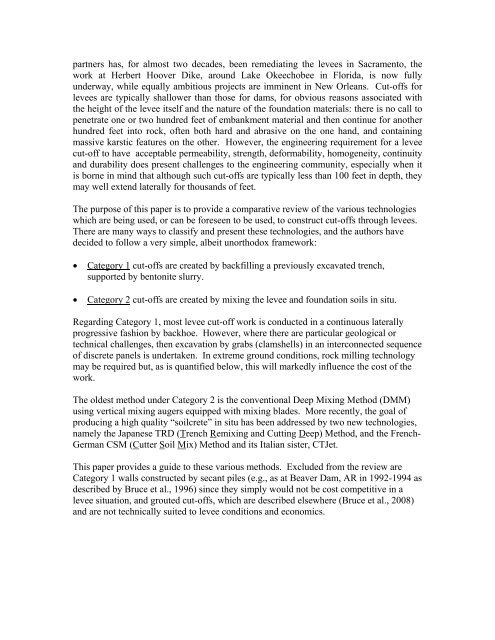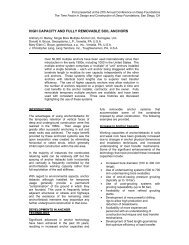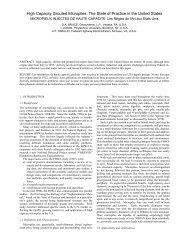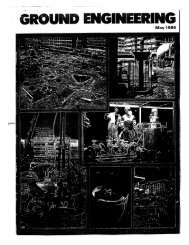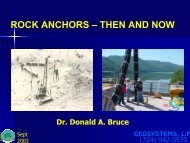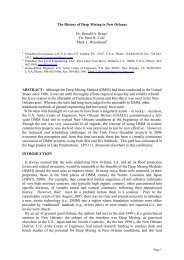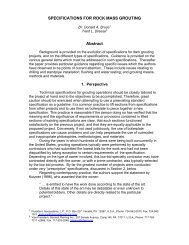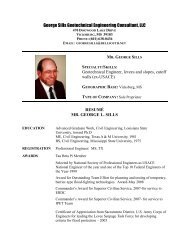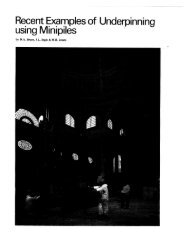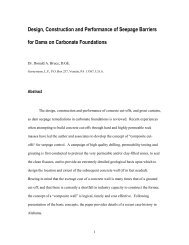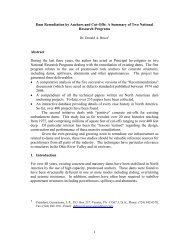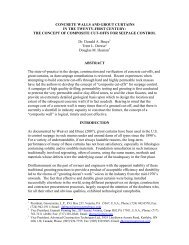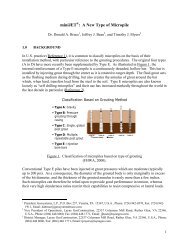SEEPAGE CUT-OFFS FOR LEVEES: A ... - Geosystems, L.P.
SEEPAGE CUT-OFFS FOR LEVEES: A ... - Geosystems, L.P.
SEEPAGE CUT-OFFS FOR LEVEES: A ... - Geosystems, L.P.
You also want an ePaper? Increase the reach of your titles
YUMPU automatically turns print PDFs into web optimized ePapers that Google loves.
partners has, for almost two decades, been remediating the levees in Sacramento, the<br />
work at Herbert Hoover Dike, around Lake Okeechobee in Florida, is now fully<br />
underway, while equally ambitious projects are imminent in New Orleans. Cut-offs for<br />
levees are typically shallower than those for dams, for obvious reasons associated with<br />
the height of the levee itself and the nature of the foundation materials: there is no call to<br />
penetrate one or two hundred feet of embankment material and then continue for another<br />
hundred feet into rock, often both hard and abrasive on the one hand, and containing<br />
massive karstic features on the other. However, the engineering requirement for a levee<br />
cut-off to have acceptable permeability, strength, deformability, homogeneity, continuity<br />
and durability does present challenges to the engineering community, especially when it<br />
is borne in mind that although such cut-offs are typically less than 100 feet in depth, they<br />
may well extend laterally for thousands of feet.<br />
The purpose of this paper is to provide a comparative review of the various technologies<br />
which are being used, or can be foreseen to be used, to construct cut-offs through levees.<br />
There are many ways to classify and present these technologies, and the authors have<br />
decided to follow a very simple, albeit unorthodox framework:<br />
• Category 1 cut-offs are created by backfilling a previously excavated trench,<br />
supported by bentonite slurry.<br />
• Category 2 cut-offs are created by mixing the levee and foundation soils in situ.<br />
Regarding Category 1, most levee cut-off work is conducted in a continuous laterally<br />
progressive fashion by backhoe. However, where there are particular geological or<br />
technical challenges, then excavation by grabs (clamshells) in an interconnected sequence<br />
of discrete panels is undertaken. In extreme ground conditions, rock milling technology<br />
may be required but, as is quantified below, this will markedly influence the cost of the<br />
work.<br />
The oldest method under Category 2 is the conventional Deep Mixing Method (DMM)<br />
using vertical mixing augers equipped with mixing blades. More recently, the goal of<br />
producing a high quality “soilcrete” in situ has been addressed by two new technologies,<br />
namely the Japanese TRD (Trench Remixing and Cutting Deep) Method, and the French-<br />
German CSM (Cutter Soil Mix) Method and its Italian sister, CTJet.<br />
This paper provides a guide to these various methods. Excluded from the review are<br />
Category 1 walls constructed by secant piles (e.g., as at Beaver Dam, AR in 1992-1994 as<br />
described by Bruce et al., 1996) since they simply would not be cost competitive in a<br />
levee situation, and grouted cut-offs, which are described elsewhere (Bruce et al., 2008)<br />
and are not technically suited to levee conditions and economics.


